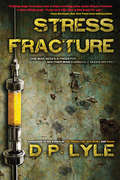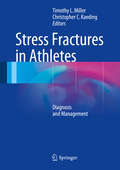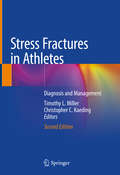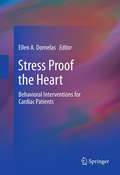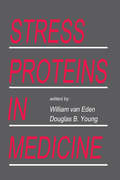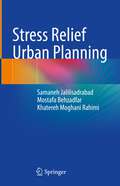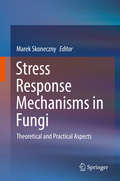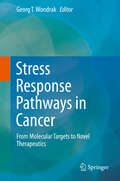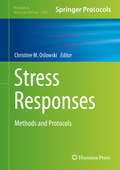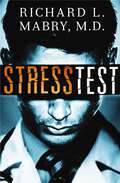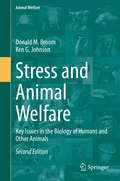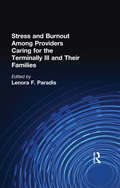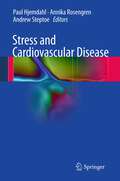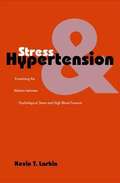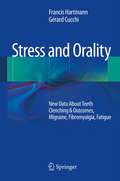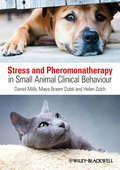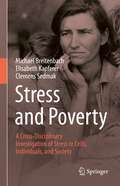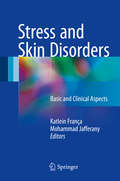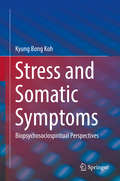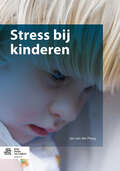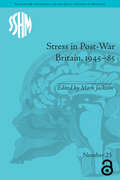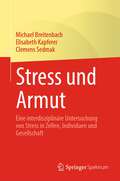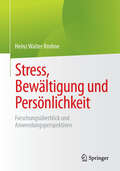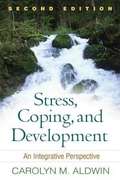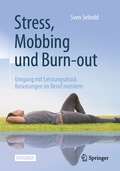- Table View
- List View
Stress Fracture
by D P LyleWhen Dub Walker's close friend Sheriff Mike Savage becomes the victim of a gruesome murder, the forensic expert is called upon to track down the serial killer who's been terrorizing the county. Having been involved in more than 100 cases of foul play and witnessed the bloody remains of rape, torture, and unthinkable mutilation, Dub thought he had seen it all-yet the killer is unlike any murderer Dub has ever encountered. Vacillating between wildly divergent personalities fueled by post traumatic stress disorder-at times calm, cold, and calculating; at others maniacal and out of control-the psychopath taunts, threatens, and outmaneuvers Dub at every turn. The stakes are suddenly elevated as Dub uncovers a deadly conspiracy tainted with unrestrained greed, corruption, and ties to the military establishment and the medical community.
Stress Fractures in Athletes
by Christopher C. Kaeding Timothy L. MillerStress fractures are fatigue failures of bone caused by unusual or repeated stress on bone and are among the more common sports injuries encountered. Often going unreported or occasionally unnoticed, athletes run the risk of a more serious fracture if untreated. Stress Fractures in Athletes focuses on the presentation, evaluation and treatment of these injuries. Divided into two sections, the first part provides in-depth description of the pathophysiology, epidemiology and biomechanics of stress fractures, as well as a discussion of classification, imaging and some general treatment concepts. The second part expands on treatment and takes each relevant anatomical region into consideration: lumbar spine, pelvis, femur, knee, tibia, upper and lower extremities, and the ribs and shoulder girdle. A chapter on insufficiency fractures, commonly associated with osteopenia and osteoporosis, is also included. As such, Stress Fractures in Athletes are a comprehensive resource for sports medicine practitioners, orthopedic surgeons, primary care physicians and physical therapists alike.
Stress Fractures in Athletes: Diagnosis and Management
by Christopher C. Kaeding Timothy L. MillerNow completely revised and expanded, this second edition not only includes updated chapters detailing treatment of the most common and troublesome sites for stress fractures, but also more recent research regarding risk factors for the development of stress fractures. As in the original edition, general principles of evaluation, healing considerations and management strategies are discussed in three thematic sections. However, unlike the previous text, this edition will focus on a holistic approach to the treatment of these increasingly common injuries with new chapters on nutritional optimization of athletes at risk for stress fractures, systemic treatment strategies for healing including vitamin D supplementation and parathyroid hormone stimulation, and surgical and injectable biologic treatment modalities for enhanced bone healing. This edition will also include guidelines for on-the-field and training room management of stress fractures for team physicians. This revision is timely, given the increasing rate and severity of bony stress injuries encountered in elite and professional athletes related to single-sport specialization and the increased popularity of endurance sports such as cross-fit, obstacle course racing, and ultramarathon competitions. It will be an ideal resource for sports medicine practitioners including orthopedic surgeons, primary care sports medicine specialists, athletic trainers, and physical therapists.
Stress Proof the Heart: Behavioral Interventions for Cardiac Patients
by Ellen A. DornelasCardiovascular disease is a leading cause of death throughout the world. Chronic negative emotions such as depression and anxiety place cardiac patients at greater risk for death and recurrence of cardiovascular disease. In 2008 the editor published a book related to this topic, titled Psychotherapy with Cardiac Patients: Behavioral Cardiology in Practice (American Psychological Association). Aside from that book, there are very few resources specifically written for clinicians who treat psychologically distressed cardiac patients. Unlike other medical specialty areas such as oncology, the field of cardiology has been slow to integrate behavioral treatments into the delivery of service. Perhaps because the field has been largely defined and dominated by researchers, mental health clinicians are only starting to recognize behavioral cardiology as a viable arena in which to practice. There is a large void in the practitioner literature on behavioral cardiology. In a review of Psychotherapy with Cardiac Patients, Paul Efthim, Ph.D. wrote, "Her new book goes well beyond previous works by giving specific and detailed guidance about how to tailor psychological interventions with this variegated population." He added, "It would benefit from even more details about treatment approaches." This proposed volume goes beyond the editor's previous volume by providing in-depth descriptions of behavioral treatments for distressed cardiac patients written by eminent leaders in behavioral cardiology. This book describes a wide range of behavioral treatments for the common psychologically based problems encountered by clinicians who treat cardiac patients. The book is organized as follows: Part I focuses on the most psychologically challenging and common presentations of cardiac diagnosis; coronary artery disease, arrhythmia, and heart failure. This section also includes a chapter on heart transplantation, which is a treatment, not a diagnosis, but a treatment that incurs profound psychological impact for the individual. In Part II, behavioral interventions for the general cardiac population are described. Mainstream therapies such as stress management, cognitive-behavioral therapy, and medical family therapy are described, along with approaches that have less empirical support but considerable practical significance such as personality-guided therapy and interventions aimed at altering type D personality traits. The literature in behavioral cardiology has a rich history of investigating maladaptive personality traits and thus it is important to include behavioral approaches that target personality in this volume. Part III focuses on common behavioral problems encountered by clinicians who work with this patient population. Most patients who seek psychological help do so because they perceive themselves to be stressed due to their job or overextended in all areas of their life. Other people with heart disease present with sleep problems and/or an inability to motivate themselves to exercise or quit smoking. There are many practical behavioral approaches that can be helpful for patients with these difficulties and these are detailed in this section of the book. The conclusion of the book focuses on how to integrate the behavioral treatments described in the preceding chapters into a comprehensive treatment model.
Stress Proteins in Medicine
by Willem Van EdenProvides a thorough overview of current knowledge of stress proteins in both normal and disease physiology and evaluates the potential for developing novel diagnostic, prophylactic, and therapeutic approaches to control human disease based on the latest stress-protein research.
Stress Relief Urban Planning
by Samaneh Jalilisadrabad Mostafa Behzadfar Khatereh Moghani RahimiLiving in urban areas has long been recognized as a risk factor for mental illness despite the advantages of cities over villages. The impact of urbanization on mental health and stress is significant and is likely to increase over the next few years. Thus, considering the stress difference in the world cities and its increase, urban planners, urban managers, and urban designers should urgently consider it an essential principle in their plans and designs to reduce its side effects. This book is a comprehensive guide for urban planners who seek to reduce urban stress in the urban environment but lack proper training and texts. Urban designers will have a unified vision to reduce urban stress caused by the appearance of the city environment. It will be useful for city managers and policymakers since this book identifies urban policies which reduce urban stress and stressful urban factors. Also, it will help urban psychologists, sociologists, architects, and social science researchers to better understand the relationship between their field and stress relief urban planning.
Stress Response Mechanisms in Fungi: Theoretical and Practical Aspects
by Marek SkonecznyThis book covers both the molecular basics of fungal stress response strategies as well as biotechnological applications thereof. The complex regulatory mechanisms of stress response pathways are presented in a concise and well-readable manner. Also, light will be shed on the interconnection of pathways responding to different types of stress. Profound knowledge of stress responses in yeast and filamentous fungi is crucial for further optimization of industrial processes. Applications are manifold, for example in fungicide development, for improving the resistance of crop plants to fungal pathogens, but also in medicine to help curing fungal infections. The book targets researchers from academia and industry, as well as graduate students interested in microbiology, mycology and biomedicine.
Stress Response Pathways in Cancer
by Georg T. WondrakIt is now established that dysregulated cell stress response pathways play a critical role in tumorigenesis, and a refined mechanistic understanding of this phenomenon at the molecular level promises to open new avenues for targeted therapeutic strategies that may benefit cancer patients in the near future. Coauthored by recognized leaders in cancer research from five continents, this novel book provides a comprehensive perspective on cell stress response pathways and therapeutic opportunities. Focusing on the role of genotoxic, proteotoxic, oxidative, metabolic, and inflammatory stress in tumorigenesis, the book is essential reading for students, basic researchers, and biomedical health care professionals interested in cancer and therapeutic development.
Stress Responses
by Christine M. OslowskiThis volume focuses on detecting different cellular stresses, measuring pathological consequences within the cell, and investigating the role of cellular stresses in select diseases. In addition, this book reviews the crosstalk between different stress pathways, stress responses during ageing, and targeting stress for regenerative medicine. Written in the highly successful Methods of Molecular Biology series format, chapters include introductions to their respective topics, lists of the necessary materials and reagents, step-by-step, readily reproducible laboratory protocols, and key tips on troubleshooting and avoiding known pitfalls. Authoritative and instructive, Stress Responses: Methods and Protocols seeks to aid scientists to further study multiple stress pathways and outcomes triggered by such stresses. In depth knowledge of cellular stress will eventually lead to the development of novel therapeutics to prevent or treat related diseases.
Stress Test
by Richard MabryTHEY MAY NOT HAVE ENOUGH EVIDENCE TO CONVICT HIM, BUT THEY HAVE ENOUGH TO RUIN HIS LIFE. Dr. Matt Newman thought he was leaving his life as a surgeon in private practice for a better one in academic medicine. But the kidnappers who attacked him as he left the hospital at 2 a.m. have no such plans--they just want him dead. Bound and in the trunk of his car, Matt's only thought is fleeing with his life. He does escape, but at a price: a head injury that lands him in the ICU . . . where he awakens to discover he's being charged with murder. Sandra Murray is a fiery, redheaded lawyer who swore she was done with doctors after her last relationship. But when Matt calls, she knows she can't walk away from defending someone who is truly innocent. Matt's career is going down the drain. His freedom and perhaps his life may be next. But with the police convinced he's a killer and the kidnappers still trying to finish what they started, finding the truth--and the faith to keep going--will be the toughest stress test Matt has ever endured. "This is a terrific read, by a surgeon who clearly knows his stuff as a doctor and his craft as a writer." --MICHAEL PALMER, New York Times best-selling author of Oath of Office
Stress and Animal Welfare: Key Issues in the Biology of Humans and Other Animals (Animal Welfare #19)
by Donald M. Broom Ken G. JohnsonThis is the Second Edition of a well-received book that reflects a fresh, integrated coverage of the concepts and scientific measurement of stress and welfare of animals including humans. This book explains the basic biological principles of coping with many forms of adversity. The major part of this work is devoted to explaining scientifically usable concepts in stress and welfare. A wide range of welfare indicators are highlighted in detail with examples being drawn from man and other species. The necessity for combining information from disciplines is emphasized with a one-health, one-welfare approach. This information forms the basis for a synthesis of new ideas. Among the issues covered are:- How brain and body systems regulate using feelings, physiological responses, behaviour and responses to pathology- Limits to adaptation- Assessing positive and negative welfare during both short-term and long-term situations- Ethical problems and suggested solutionsA proper assessment of animal welfare is essential to take informed decisions about what is morally acceptable in terms of practice and in the development of a more effective legislation. This work encapsulates a very wide body of literature on scientific aspects of animal welfare and will thus prove a valuable asset for animal welfare scientists, psychologists, students and teachers of all forms of biology, behaviour, medicine, veterinary medicine and animal usage.
Stress and Burnout Among Providers Caring for the Terminally Ill and Their Families
by Lenora F ParadisWritten primarily by individuals with hands-on hospice experience, this crucial volume identifies sources of stress among hospice workers and provides workers and managers with strategies to cope with those stressors. It is an enlightening examination of diverse theoretical perspectives and a much needed investigation on stress and burnout for hospice providers and caregivers. Readers will find concrete suggestions for the alleviation of stress and burnout in their work with the terminally ill, as well as theoretical and research discussions. The authors explore a wide range of subjects and problems faced by nurses, physicians, social workers, caregivers, hospice directors, and volunteers. They also discuss the many factors in hospice care that may foster unfavorable stress reactions and eventual burnout among hospice professionals. Current literature on job stress and burnout among those who care for the terminally ill is examined and a model of stress and burnout specific to hospice caregivers is presented. The authoritative chapters also identify theories of stress and burnout and the distinction between the two. Anyone who deals with chronic and terminal illness should read Stress and Burnout Among Providers Caring for the Terminally Ill and Their Families. Hospice caregivers and volunteers, social works, clergy, and health care professionals who work with cancer, renal dialysis, and heart and stroke patients will appreciate the attention given to a subject that has received little study.
Stress and Cardiovascular Disease
by Andrew Steptoe Paul Hjemdahl Annika RosengrenThe main aim of this book is to evaluate the concept of stress and provide tools for physicians to identify patients who might benefit from stress management. This will incorporate a detailed description of the physiological and pathophysiological consequences of acute and chronic stress that might lead to cardiovascular disease. The book will aim to critically evaluate interventional research (behavioural and other therapies) and provide evidence based recommendations on how to manage stress in the cardiovascular patient. Our intentions are to define and highlight stress as an etiological factor for cardiovascular disease, and to describe an evidence based "tool box" that physicians may use to identify and manage patients in whom stress may be an important contributing factor for their disease and their risk of suffering cardiovascular complications.
Stress and Hypertension: Examining the Relation between Psychological Stress and High Blood Pressure
by Kevin T. LarkinIn this authoritative and comprehensive book, Kevin T. Larkin examines more than a half-century of empirical evidence obtained to test the common assumption that stress is associated with the onset and maintenance of essential hypertension (high blood pressure). While the research confirms that stress does play a role in the exacerbation of essential hypertension, numerous other factors must also be considered, among them obesity, exercise, and smoking, as well as demographic, constitutional, and psychological concerns. The author discusses the effectiveness of strategies developed to manage stress and thereby lower blood pressure and concludes with suggestions and directions for further study.
Stress and Orality: New Data About Teeth Clenching & Outcomes, Migraine, Fibromyalgia, Fatigue
by Francis Hartmann Gérard CucchiAre oral disorders only an issue for dentists? The answer is no. If your patients complain of pain and/or discomfort, if some are diagnosed as suffering from migraines, fibromyalgia or chronic fatigue, and if classical therapies have remained ineffective, this book could help in your daily practice. When it comes to the complex pathology called Temporo-Mandibular Disorders (TMD) most specialists favour a multidisciplinary approach and treatment of socio-psycho-emotional factors as well as dental, lingual or postural disorders. Yet little is known - from a clinical point of view - about a tricky oral spastic habit called severe teeth clenching. In view of the lack of clinical findings from classical investigations on the subject, it could be considered as the "hidden part of an oral parafunctional iceberg". Neuroscience has been able to shed some light on the multiple connections between trigeminal and non-trigeminal nervous centres, which confirms the significant involvement of the stomatognathic system and trigeminal nerves (V) in both oral as well as non-oral major functions such as eating, breathing, speaking, hearing, and standing ... and also confirms the extensive participation of the paired Vs in the human adaptation process. Too many physicians are still reluctant to admit the pathological responsibilities of the Vs. Therefore their role remains largely underestimated by clinicians. Stress conditions in introverted people cause a parafunctional habit (i.e. severe clenching), which in turn produces trigeminal overstimulation and nociception. Through a process of sensitization this can perturb some non-trigeminal nervous areas, such as the vestibular nuclei and cerebellum (involved in equilibrium). Would you then be willing to accept the possibility that a stressed and introverted patient who clenches hard, durably or frequently may end up suffering from dizziness? If not, this book is not for you. But if you accept the scientific data and clinical facts this book will offer a concrete therapeutic protocol: the Relaxing and Moderating Treatment (RMT), which can greatly help you to familiarize yourself with and neutralize this little known deleterious spastic oral parafunction and its many disconcerting pain-causing and dysfunctional clinical effects. Prepare to be amazed by the results, just as we were!
Stress and Pheromonatherapy in Small Animal Clinical Behaviour
by Daniel S. Mills Helen Zulch Maya Braem DubeStress and Pheromonatherapy in Small Animal Clinical Behaviour is about how stress impacts on animal behaviour and welfare and what we can do about it, especially by using chemical signals more effectively. This readily accessible text starts from first principles and is useful to both academics and practitioners alike. It offers a framework for understanding how pheromonatherapy can be used to encourage desirable behaviour in dogs and cats and also a fresh approach to understanding the nature of clinical animal behaviour problems.The authors have pioneered the use of pheromone therapy within the field of clinical animal behaviour. As the culmination of many years of research and experience, they offer sound evidence-based advice on how and when pheromones can be used most effectively.The first part of the book deals with some fundamental concepts, focusing on the key concepts of stress, communication and perception. It then provides a framework for the evaluation of problem behaviour to allow consideration of the possible role or not of pheromonatherapy. Part 2 covers the application of these concepts to a range of specific situations, concentrating on conditions in which there has been most research to support the efficacy of pheromonatherapy.Suitable for veterinarians in small animal practice, students of clinical animal behaviour, veterinary nurses and technicians, as well as specialists and researchers in animal behaviour therapy.
Stress and Poverty: A Cross-Disciplinary Investigation of Stress in Cells, Individuals, and Society
by Clemens Sedmak Michael Breitenbach Elisabeth KapfererThe word stress is everywhere and highly overused. Everyone is stressed, it seems, all the time. Looking into the meaning of stress in the natural science and the humanities, this book explores cellular stress as cause of and in correlation with what humans experience as stress. When do we psychologically feel stress and when do we show physiological evidence of stress in our brain? Stress is a deviation from what feels normal and healthy. It can be created by social or economic factors and become chronic, which has substantial impacts on the individual and society as a whole. Focusing on poverty as one chronic inducer of stress, this book explores how the lack of pressure-free time, the hardships and unpredictability of everyday life and a general lack of protection lead to destructive toxic stress. This pressure affects cognitive and social functioning, brain development during childhood and may also result in premature aging. How can the sciences inform our understanding of and our response to stress? What can be done about toxic stress both on a personal level and in terms of structures and policies? The book is written for anyone interested in stress, its causes and consequences, and its relationship to poverty.
Stress and Skin Disorders
by Katlein França Mohammad JafferanyDermatological conditions are intimately related to stress. Stress can affect, reveal or even exacerbate a number of skin disorders, including alopecia, seborrheic dermatitis, psoriasis, atopic dermatitis, pruritus, herpes, lichen planus, rosacea and urticarial. On the other hand, the skin disease itself could induce a secondary stress for the patient, influencing his or her quality of life. There is increasing evidence that stress influences disease processes and contributes to inflammation through the modulating hypothalamicpituitary- adrenal axis - releasing neuropeptides, neurotrophins, lymphokines and other chemical mediators from nerve endings to dermal cells. This is one of the first books published on this topic, focusing more on the basic science aspects of stress in dermatopathology (oxidants, antioxidants, and oxidative injury in dermatopathology, dermatopharmacology, and dermatotoxicology. ) Most Psychodermatology texts adopt a practical approach to identify all types of Psychodermatology disorders, focusing on clinical treatment. This concise title offers a comprehensive and didactic approach to skin diseases caused or exacerbated by stress, as well as covers the immunology, role and effect of stress on skin disease, and quality of life in dermatology. In the current programs of medical residency in dermatology, little is taught about the relationship between stress and skin diseases and this book is an important tool for young dermatologists and psychodermatologists in training.
Stress and Somatic Symptoms: Biopsychosociospiritual Perspectives
by Kyung Bong KohThis book focuses on the assessment and treatment of patients with somatic symptoms, based on biopsychosociospiritual model. Specific assessment skills and treatment techniques are required to approach them effectively. A broad spectrum of knowledge about stress is also needed because stress is closely related to the onset and course of disorders with somatic symptoms.This book consists of four parts. Part 1 ‘Stress’ explores stress, vulnerability, and resilience; intermediate mechanisms between stress and illnesses such as psychoendocrinology and psychoimmunology; the measurement of stress; and the relationship between stress and accidents.Part 2 ‘Somatization’ deals with the concept, mechanisms, assessment, and treatment of somatization. In addition, somatic symptom and related disorders in DSM-5 is included. However, the approach to chronic pain is separately added to this part because pain is a major concern for patients with these disorders. Part 3 ‘Specific physical disorders’ mainly deals with common and distressing functional physical disorders as well as major physical disorders. Therapeutic approach for individuals at risk of coronary heart disease is also included.Part 4 ‘Religion, spirituality and psychosomatic medicine’ emphasizes the importance of a biopsychosociospiritual perspective in an approach for patients with somatic symptoms, especially depressed patients with physical diseases and patients with terminal illnesses because of the growing need for spirituality in such patients. This book explores stress and a variety of issues relevant to the assessment and treatment of disorders with somatic symptoms in terms of biopsychosociospiritiual perspectives. It will be of interest to researchers and healthcare practitioners dealing with stress, health and mental health.
Stress bij kinderen
by Jan Van PloegEen toegankelijk en informatief geschreven handboek voor voornamelijk zorgprofessionals die te maken krijgen met kinderen van 0 tot 18 jaar die gebukt gaan onder stress en trauma. De tweede doelgroep bestaat uit ouders en studenten. Het zijn niet alleen extreme situaties die bij kinderen veel stress kunnen veroorzaken; ook kleine dagelijkse weerkerende negatieve gebeurtenissen kunnen veel stress met zich meebrengen.
Stress in Post-War Britain (Studies for the Society for the Social History of Medicine #23)
by Mark JacksonIn the years following World War II the health and well-being of the nation was of primary concern to the British government. The essays in this collection examine the relationship between health and stress in post-war Britain through a series of carefully connected case studies.
Stress und Armut: Eine interdisziplinäre Untersuchung von Stress in Zellen, Individuen und Gesellschaft
by Clemens Sedmak Michael Breitenbach Elisabeth KapfererDas Wort Stress ist allgegenwärtig und ist ein Modewort geworden. Jeder ist gestresst, so scheint es, und das fortwährend. Dieses Buch befasst sich mit der Bedeutung von Stress in den Natur- und Geisteswissenschaften und untersucht zellulären Stress als Ursache für Stress und im Zusammenhang mit dem, was Menschen als Stress erleben. Wann empfinden wir in psychologischem Sinn Stress und wann zeigen wir physiologische Anzeichen von Stress in unserem Gehirn?Stress ist eine Abweichung von dem, was sich „normal“ und gesund anfühlt. Er kann durch soziale oder ökonomische Faktoren ausgelöst werden und kann chronisch werden, was erhebliche Auswirkungen auf den einzelnen Menschen und auf die Gesellschaft als Ganzes hat. Dieses Buch konzentriert sich auf Armut als eine chronische Ursache von Stress und untersucht, wie der Mangel an druckfreier Zeit, die Entbehrungen und die Unvorhersehbarkeit des Alltags sowie ein allgemeiner Mangel an Schutz zu destruktivem toxischem Stress führen. Dieser permanente Druck beeinträchtigt die kognitiven und sozialen Funktionen, die Gehirnentwicklung in der Kindheit und kann auch zu vorzeitiger Alterung führen. Was können die Wissenschaften für unser Verständnis von und unsere Reaktion auf Stress leisten? Was kann gegen toxischen Stress getan werden, sowohl auf persönlicher Ebene als auch in Bezug auf Strukturen und politische Maßnahmen?Das Buch richtet sich an alle, die sich für Stress, seine Ursachen und Folgen sowie für den Zusammenhang von Stress und Armut interessieren.
Stress, Bewältigung und Persönlichkeit: Forschungsüberblick und Anwendungsperspektiven
by Heinz Walter KrohneDieses Buch liefert einen Brückenschlag zwischen den Erfahrungen von Menschen mit Stress und Stressbewältigung, der neuesten Forschung in diesem Bereich und den Anwendungsmöglichkeiten der Praxis. Sein wesentliches Thema ist die Bedeutung von Unterschieden zwischen Menschen im Erleben und Bewältigen von Belastungen. Daraus folgt die Notwendigkeit, die präventive und therapeutische Praxis im Hinblick auf das Erreichen einer wirksamen Stressbewältigung an diese Unterschiede anzupassen. Betrachtet man diese (relativ stabilen) Unterschiede zwischen Menschen, so ergibt sich für die Praxis eine wesentliche Konsequenz: Eine generell (also für alle Betroffenen) empfohlene und praktizierte Form der Bewältigung (z.B. Ablenkung, Entspannung, Achtsamkeit auf Prozesse im eigenen Körper) kann zwar bei bestimmten Personen hilfreich sein, bei anderen Menschen aber eher negativ wirken. So lassen sich Personen prinzipiell in zwei Gruppen einordnen: Vermeidende Personen haben die Tendenz, belastenden Ereignissen bzw. Erlebnissen aus dem Weg zu gehen, etwa indem sie die Schwere der Belastung herunterspielen oder sich gar nicht erst mit ihr befassen. Überwachern geht es hingegen darum, möglichst viel Information über eine Belastung (z.B. eine bevorstehende Operation) zu erhalten, um sich so sicherer zu fühlen und die Situation besser kontrollieren zu können. Methoden zur Messung dieser Merkmale werden beschrieben sowie Forschungen vorgestellt, die die jeweils optimale Bewältigung bei vermeidenden bzw. überwachenden Personen beschreiben. Auf der Grundlage dieser Thematik werden Möglichkeiten zur praktischen Anwendung vorgestellt, die auf Erkenntnissen aus diesen Forschungen beruhen. Dabei konzentriert sich das Buch auf drei Felder: • Gesundheit mit den beiden Themen Bewältigung und körperliche Gesundheit sowie psychologische Behandlung von Patienten bei medizinischen Eingriffen • Stressbewältigung und Leistungsverhalten • Prävention im Hinblick auf den Einfluss der Sozialisation (speziell der elterlichen Erziehung) auf die Entwicklung der Stressbewältigung beim Kind Die Zielgruppen • Studierende, Lehrende und Praktiker der (Gesundheits-)Psychologie, Sozial-, Gesundheits- und Erziehungswissenschaften, die Informationen zu hier bedeutsamen wissenschaftlichen Themen (u.a. Gesundheitsverhalten und -erziehung, Leistungsanforderungen, Sozialisationsprozesse) suchen. • Personen, die für die Bewältigung ihrer alltäglichen Belastungen das Angebot der vielen hierzu vorliegenden Ratgeber nicht befriedigt und nach auf neuesten wissenschaftlichen Erkenntnissen basierenden, Informationen suchen
Stress, Coping, and Development, Second Edition
by Carolyn AldwinHow do people cope with stressful experiences? What makes a coping strategy effective for a particular individual? This volume comprehensively examines the nature of psychosocial stress and the implications of different coping strategies for adaptation and health across the lifespan. Carolyn M. Aldwin synthesizes a vast body of knowledge within a conceptual framework that emphasizes the transactions between mind and body and between persons and environments. She analyzes different kinds of stressors and their psychological and physiological effects, both negative and positive. Ways in which coping is influenced by personality, relationships, situational factors, and culture are explored. The book also provides a methodological primer for stress and coping research, critically reviewing available measures and data analysis techniques. New to This Edition Incorporates advances in concepts, tools, and data. Chapters addressing physiology and physical health. Expanded coverage of sociocultural and religious aspects of coping, and of childhood, young adulthood, and mid-life. New perspectives on emotion regulation and stress-related growth.
Stress, Mobbing und Burn-out: Umgang mit Leistungsdruck — Belastungen im Beruf meistern
by Sven SeiboldStress gilt als eine der größten Gesundheitsgefahren – häufig ist die Ursache der Dauerstress, den Leistungs- und Zeitdruck am Arbeitsplatz erzeugen. Dabei kann Stress positiv wirken, wenn die Bedingungen stimmen. Die Autoren zeigen, wie sich ein Weg zwischen negativem Stress und positiven Herausforderungen finden lässt. Dazu liefern sie Grundlagenwissen zur Entstehung und zu den Folgen von Stress sowie praxisorientierte Methoden zur Stressbewältigung. Neu in der 6. Auflage: Material zu Mobbing und Burn-out sowie Hinweise zu rechtlichen Problemen.
